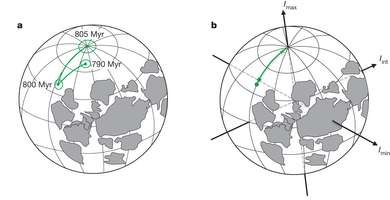Modelling palaeomagnetically inferred TPW during the Neoproterozoic. Credit: (c) Nature 491, 244–248. doi:10.1038/nature11571
(Phys.org)—Researchers using computer simulations and modeling have come up with two possible explanations for the phenomenon known as true polar wandering. The team led by Jessica Creveling of Harvard University, suggest in their paper published in the journal Nature, that dramatic shifts in the Earth's surface over millions of years, and then a return to the previous state, can be explained by bulging at the equator and elasticity of the planets outer shell.
Scientists have known for many years that there are two kinds of shifting of the Earth's surface. One is continental drift; the other is true polar wander where all the continents move together due to an out-of-the-ordinary event, such as the melting of a large ice field or the formation of a large volcano. And while researchers have come to understand the processes that can cause large shifts to occur together over a period of time, they have been at a loss to explain how those very same parts mange to eventually move back to where they came from. In this new research, the team suggests it has to do with how the Earth is shaped, and the elasticity of rock in the planet's mantle.
The researchers note that the Earth is not perfectly round – it's more of a compressed sphere with bulging occurring at the equator. This works to keep the planet stabilized and causes the continents to bounce back slightly if nudged out of their normal continental drift. That's the first explanation for why the topography of the planet is able to bounce back from an unsteadying upheaval. The second, they say is due to the elasticity of the mantle itself. When an abrupt change forces major movement of the mantle and the crust, potential energy is stored in the rock in the same way as happens with a rubber band when it's twisted. Once the forces that caused the initial changes subside, the potential energy takes over, pushing the continents back to where they were before the upheaval occurred.
The researchers came to these conclusions after studying metal deposits in the ground which are known to line up with the Earth's magnetic field. Doing so provides clues about the orientation of the planet during different times in history. Using such clues they built computer models and simulations that led to their proposed explanations of true polar wander. They suggest that such movement isn't about to happen again anytime soon however, as their study found that Earth has rotated just 30 degrees over the past 200 million years.
More information: Mechanisms for oscillatory true polar wander, Nature 491, 244–248 (08 November 2012) doi:10.1038/nature11571
Abstract
Palaeomagnetic studies of Palaeoproterozoic to Cretaceous rocks propose a suite of large and relatively rapid (tens of degrees over 10 to 100 million years) excursions of the rotation pole relative to the surface geography, or true polar wander (TPW). These excursions may be linked in an oscillatory, approximately coaxial succession about the centre of the contemporaneous supercontinent. Within the framework of a standard rotational theory, in which a delayed viscous adjustment of the rotational bulge acts to stabilize the rotation axis, geodynamic models for oscillatory TPW generally appeal to consecutive, opposite loading phases of comparable magnitude. Here we extend a nonlinear rotational stability theory10 to incorporate the stabilizing effect of TPW-induced elastic stresses in the lithosphere. We demonstrate that convectively driven inertia perturbations acting on a nearly prolate, non-hydrostatic Earth with an effective elastic lithospheric thickness of about 10 kilometres yield oscillatory TPW paths consistent with palaeomagnetic inferences. This estimate of elastic thickness can be reduced, even to zero, if the rotation axis is stabilized by long-term excess ellipticity in the plane of the TPW. We speculate that these sources of stabilization, acting on TPW driven by a time-varying mantle flow field, provide a mechanism for linking the distinct, oscillatory TPW events of the past few billion years.
Journal information: Nature
© 2012 Phys.org




















